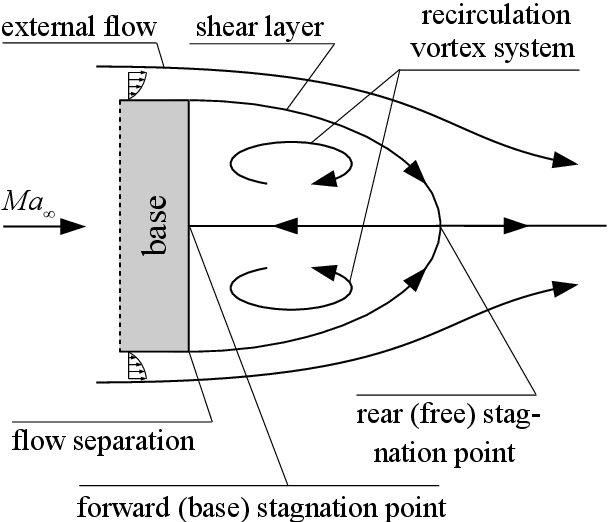Updated

Potential flow panel methods are rooted in inviscid flow theory. This assumes that the fluid is frictionless and that the flow is irrotational, meaning that the fluid particles do not rotate as they move. While this simplification is useful for many engineering applications, it does not account for the viscous effects that occur in real-world flows. Viscous effects, such as boundary layer thickness and separation, can significantly impact the lift and drag characteristics of an airfoil, making it essential to incorporate these effects into aircraft design simulations.
At its core, FlightStream is a potential flow solver. However, our engineers have incoporated models which allow users to toggle on or off several physics models to account for viscous effects and separated flow regimes.
Base regions are regions of highly separated flow that occur on the aft end of bluff bodies. These regions are characterized by a large wake and a recirculation zone. FlightStream uses a simplified model to apply a uniform pressure to these regions. The user can utilizing the Nash model, which applies a Cp of -0.2 to the region or a User defined Cp can be specified. Most literature says that this value is between -0.2 to -0.5 depending on the aft surface cross section.
This model is useful for estimating the drag of bluff bodies. One thing to note, is that at the edges of the recirculation zone a shear layer is formed. In panel methods, this well defined shear layer is a source of voriticity shedding. As such, FlightStream requires that the edges of the base region be defined as Trailing Edges to appropriately capture this voriticity shedding effect into the wake.
The most common model utilized is the viscous coupling model. This setting enables a secondary viscous-corrected solution after the initial invisicd solution completes. After the inviscid pressure distribution is attained, the boundary layer properties are estimated, and a normal transpiration boundary condition is applied on the surface of all boundaries to simulate the effects of the boundary layer on the geometry. This model allows estimation of boundary layer parameters such as displacement thickness and moment thickness from laminar to turbulent boundary layers, including the transition point.
This model allows for the estimation of fully separated boundary layers along wing/fin type components. Using the popular pressure-gradient based model, the Stratford separation criterion, FlightStream can estimate where separation occurs as well as the surface pressure in the separated region. This model is mesh sensitive due to the required calculation of pressure gradients along surface streamlines. This model should be used when looking to estimate stall characteristics of wing components.
This model is pressure-gradient based and is similar to the Axial separation model above. However, it has modifications that make it applicable to bodies of revolution and ellipsiodal geometries, such as those found on fuselages and pylon components. The Crossflow model should be used to correctly capture the fuselage lift contribution.
Author: Daniel Enriquez